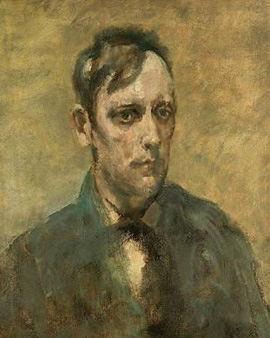


In the 19th century, at the time of Impressionism, Realism and Expressionism lived the English painter Ambrose McEvoy. In this period there were great upheavals in art. Not only did a time begin in which feelings and impressions entered art, but also more turned to the actual state instead of idealization. His family recognized his artistic talent early on and encouraged it by sending him to the Slade School of Fine Art in London. This was especially championed by James McNeill Whistler, who was a family friend.
During McEvoy's education, he was greatly influenced by Whistler, who was considered one of the most innovative artists. Along with impressionist Augustus John and portrait painter William Orpen, he formed a circle of artists. Initially, McEvoy focused primarily on landscapes in oil painting. He was inspired by the early Italian artists and the English Pre-Raphaelites. He often went to the National Gallery and copied drawings by Titian (also Titiano Vecellio) and Diego Velázquez. At the beginning of World War I, he began to turn to sketchy portrait drawings in watercolor, for which he is still known today. He frequently portrayed women from the upper class in particular. He became famous for his portrait of the American Maude Louise Baring. After he served in World War 1 for three years, his subjects changed for some time. He drew mainly important marines and soldiers. These portraits were given to the Imperial War Museum and the National Maritime Museum.
Ambrose McEvoy was a painter known for his temperament and also for his unconventional approach in the studio. He often invited his models in the evening. There was a boisterous mood there. He especially liked to draw to jazz music. He was one of the first artists to use colored light bulbs, which were new at that time. Above all, he used yellow, blue and green, giving his portraits an extraordinary depth, which he captured. At the same time, it allowed him to draw even at night. An artist once said that Ambrose McEvoy never seemed to work hard, but had great talent and a great zest for life. He was a member and also founder of several drawing groups. Among them was the New English Art Club, in whose galleries he frequently exhibited paintings of landscapes and interiors. He founded the National Portrait Society and later became a member of the International one as well. After thirty years, his portraits fell out of fashion and he was considered "common". After his death, he quickly fell into oblivion, until through his descendant, the paintings were made available to the public and are once again enjoying growing popularity.

In the 19th century, at the time of Impressionism, Realism and Expressionism lived the English painter Ambrose McEvoy. In this period there were great upheavals in art. Not only did a time begin in which feelings and impressions entered art, but also more turned to the actual state instead of idealization. His family recognized his artistic talent early on and encouraged it by sending him to the Slade School of Fine Art in London. This was especially championed by James McNeill Whistler, who was a family friend.
During McEvoy's education, he was greatly influenced by Whistler, who was considered one of the most innovative artists. Along with impressionist Augustus John and portrait painter William Orpen, he formed a circle of artists. Initially, McEvoy focused primarily on landscapes in oil painting. He was inspired by the early Italian artists and the English Pre-Raphaelites. He often went to the National Gallery and copied drawings by Titian (also Titiano Vecellio) and Diego Velázquez. At the beginning of World War I, he began to turn to sketchy portrait drawings in watercolor, for which he is still known today. He frequently portrayed women from the upper class in particular. He became famous for his portrait of the American Maude Louise Baring. After he served in World War 1 for three years, his subjects changed for some time. He drew mainly important marines and soldiers. These portraits were given to the Imperial War Museum and the National Maritime Museum.
Ambrose McEvoy was a painter known for his temperament and also for his unconventional approach in the studio. He often invited his models in the evening. There was a boisterous mood there. He especially liked to draw to jazz music. He was one of the first artists to use colored light bulbs, which were new at that time. Above all, he used yellow, blue and green, giving his portraits an extraordinary depth, which he captured. At the same time, it allowed him to draw even at night. An artist once said that Ambrose McEvoy never seemed to work hard, but had great talent and a great zest for life. He was a member and also founder of several drawing groups. Among them was the New English Art Club, in whose galleries he frequently exhibited paintings of landscapes and interiors. He founded the National Portrait Society and later became a member of the International one as well. After thirty years, his portraits fell out of fashion and he was considered "common". After his death, he quickly fell into oblivion, until through his descendant, the paintings were made available to the public and are once again enjoying growing popularity.
Page 1 / 1






